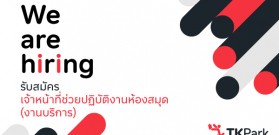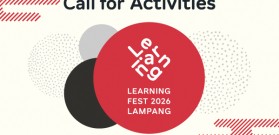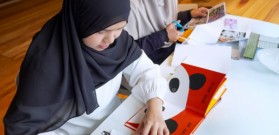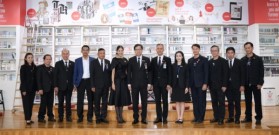Beauty and dressing are no longer trivial matters because in today’s world clothing, makeup, hairdressing and adornments are not only designed for beauty but also for the presentation of one’s “identity”. They have become a highly influential advertising tool.
Clothing trends are born and fade away as new waves constantly form and take over the old trends.
We call such trends “fashion”.
……………………………………
TK Park has been successful in producing many classes of new youth marketers. Apart from conducting a search for youth with serious business mind, it has also focused on the promotion of creativity and business that can generate social benefits.
This year, TK park organized another “TK park’s Marketing Takeoff” project under the theme of “Create, Dream, and Cultivate a Brand” for 18-25 year old youth and university students who are interested in modern marketing principles, possess learning preparedness, and want to develop a specific skill. There were as many as 200 applicants to the project but only 30 were selected to be trained by the “professionals” in the marketing and fashion circles.

Introducing Participants in the TK Park Takeoff: Youth in Marketing Program Project
The first day of the marketing and fashion training program was held on Saturday 13 July 2013 when participants attended training sessions on marketing and fashion concepts. The program was held between 11.00 am and 4.30 pm. at TK Park’s Leaning Auditorium.
Khun Assrin Nonthi-hathai, Head of TK Park’s Activities Division, welcomed the participants and explained that the underlying ideas of this project came from four words: “Create, Dream, Cultivate and Brand”. “Create” refers to face makeup and dressing which were associated with fashion. “Dream” refers to the dreams of all participants while “cultivate” refers to the realization of a dream and not letting it remain on a piece of paper or just an idea. The dream can be materialized through physical strength and will power. Finally, “brand” is the heart of this project that aims to create new fashion brands for Thailand from the power of the youth involved. The important thing is to offer everyone a chance for hands-on experience and to meet and learn from the experts.
For the morning sessions, participants got to know one another through a number of fun activities. For example, in the Speed Dating game participants were asked to write down four personal facts which provide a basis for a conversation or self-introduction to new friends. In one game, balls of different colors were thrown into a group of participants and people who caught balls of the same color had to try and beat one another by quickly calling out the name the other party.

Khun Patcharee Tiwawong talked about her experiences
The first training for the afternoon sessions was on the “Sewing Marketing Skills” during which participants learned about marketing from an expert in the field, Khun Patcharee Tiwawong, from the Creative Strategy Division of the Central marketing group (Cmg), a group of companies with marketing expertise who are importers and sale representatives of products under the license and trademarks of products trusted by worldwide consumers.
Khun Patcharee talked about the latest project that Cmg helped organize, the “120 Red Cross” function held to celebrate the 120th anniversary of the founding of the Thai Red Cross. The function was presented as an online charity with modern image and gave the new generation an opportunity to support the Thai Red Cross’ activities through donation or a purchasing of the project’s products.
Khun Patcahree revealed that the key to a marketing project’s success was to start working after extensive thinking, designing, and searching for appropriate means of communication. The question of this project was how to entice teenagers’ interest in the Thai Red Cross’ activities and to alter the old misconception that its roles were restricted to blood donation. Khun Patcharee and her team started with a study of current data and focused on four major dimensions of the activities: 1. To give – giving donation so that the money can be used to help other people; 2. To heal – via blood donation; 3. To relief – assistance to victims of flooding or other calamities; 4. To Protect – the Thai Red Cross is the prevention centre of the infectious prevention of mother-to-child infection and other diseases.

The 120 RedCross Project
For communication means, Khun Patcharee started with the Project’s “Logo”. This was an important issue that required a lot of deliberation in order to communicate the characteristics of the Thai Red Cross’ operations to everyone. The logo had to be interesting as well. For this reason part of the Thai Red Cross’ emblem was modified into a heart shape logo. Once the logo was completed Khun Patcharee suggested that it should not merely be put on display but should be used in other operations such as in its products or numbers.
The next step was to come up with short, concise and easy-to-understand words or phrases. The outcome was the phrase “Same Heart, Different Wishes” which conveys the message that each person may have different ideas and expectations but, similar to the Thai Red Cross, they wish to help others. The Thai Red Cross is the central body that dispenses assistance to everyone. In addition, Khun Patcharee also thought that once the message was decided upon, there should be a specific “gesture” that could communicate such message without spoken words. This led to the gesture of the two hands being joined at the chest in a heart shape to convey the project’s logo.
She compared marketing to the art of storytelling in that we must know who we are communicating with. With every marketing project one has to think, improve and revise the work all the time. Some works have to go through hundreds of ideas and revision in order to derive the most desired characteristic. Do not create one thing and impose it on others, expecting that everyone must like it. Never stop searching for new ideas and stop at what we think is the best idea because there is always a better idea than the best ideas.
“A lot of thinking and experimenting will produce a better thing than the best”

Khun Pichit suggests the 10 rules
In the next session, Khun Pichit Weerungkhabutr from TCDC Centre gave a lecture titled “Shaking creative ideas, beyond the marketing theoretical framework”.
Khun Pichit introduced himself with an eye-catching wording which prompted curiosity – “ Don’t talk to me, if you don’t read book” before explaining that “not reading” made a person lack fundamental knowledge in history, society, economy, culture, science and other learning. It was essential that a good marketer have a strong foundation and knew what he or she wanted.
The trends that affect everything in this world have happened before. Creating a brand requires a combination of various different groundwork. It is essential that we must learn from the past. The more we learn about history the better we can understand the future.
He further explained that in the current designing circle, countries such as Denmark have classified product design into four steps known as the “Design Ladder”:
1.No design There is no design at all, focusing solely on the product’s functions.
2.Design as styling The design focuses on beauty only.
3.Design as process There is a combined process of thinking and producing instead of application only. The design must also be tangible.
4.Design as strategy All processes are encouraged until innovation is achieved.
For the designing circle in Thailand, Khun Pichit believed that we are only in the second step. In terms of marketing, the current designs are the results of incorporating new format into the work and immediately put them on sale. This results in unsustainable designing. The heart of the creative industry is to create a strong essence that can be applied to other works on a continual basis. This is a better and more suitable form of design because the designer need not think over the work every time they start on a new project.
Khun Pichit also proposed 10 rules for becoming a good marketer and brand creator:
1. Observation, reading, research They must be observant and good at collecting data and managing their ideas. There are two major components in the fashion world – “business and design”. Both have to be carried out together. He used the word “Really?” to always remind and stimulate himself in his line of work. This means we should always question our work and not fully believe or become immersed in our idea.
2. Finding new way of storytelling In creative business we must find a different means, find new data or new method to tell a story that is “fresher” than before. “Fresh” differs from “new” because old ideas as well as new and interesting presentation methods can be infused together. This is not the same as the old ones that are already present.
3. What is your fashion statement? Identify certain statement that need to be told and communicated through new content. For example, camper’s shoes are sold not in pairs but in threes or the “Walk don’t run” slogan.
4. What does your brand stands for Identify a clear goal of what one wants to do. For example, Adidas focuses on sports products only.
5. Any cultural references Identify the origin or historical background of an item.
6. Knowledge of material and technics Having knowledge and understanding of the product’s raw materials and production techniques, such as the sewing of jeans with more adhesive and strength than ordinary sewing or the making of shoes from only three pieces of rubber.
7. Interpretation Apply, modify and retelling of original information or occurrence.
8. Perceive value Make consumers realize the product’s value. If the product is clothing consumers must be encouraged to be daring and confident in wearing them without any shame.
9. Design We must learn about designing.
10. Business model and marketing strategy holistic approved We must practice thinking and having an overall picture of the work, always collecting data. Good designing come from research and data collecting not from imagination or passion alone.

Fashion lab activities
The last activity was the “Fashion Lab” in which participants were divided into 6 teams of 5 participants each – 1) ZL Team, 2) Giant monkey team, 3) AMATA Team, 4) WARP Team, 5) Tufashionista Team, and 6) S’he Team. It was the brainstorming session in which all teams designed clothes in accordance with the set questions, develop a prototype, and jointly presented creative ideas.
Examples of interesting projects are, for example, the “Condom use among secondary educational level students” campaign where participants chose to produce umbrellas and schoolbag products that are suitable for student use. Umbrella also represented protection. In the “promotion of bicycle use” campaign reflective clothing were made because although the brightly colored sleeves can provide protection from the sun during the day, they are also reflective and suitable for cycling at night. The target groups are those interested in sports as they will be more interested in this type of product compared to the general public.
In the “Using public transport campaign”, team members plan to produce shirts that become luminescent when in the presence of people who wear the same type of shirt. This will make people want to wear the same type of shirt. This is like the good feeling and fun gained from travelling together that cannot be found in travelling alone or in driving a personal car. The “Refrain from consuming dog meat campaign” is based on the manufacturing of clothing that both dogs and their owners can wear together and the inviting of dog lovers to join the activities. Dog lovers are the powerful target group who can significantly contribute to the campaign. In the “Energy-saving campaign”, a novel presentation was chosen. “Fingers” are used to symbolize the product by conveying the message that participating in the switch the light off campaign is so easy that everyone can join. The “Turn off the light to sell product campaign” plan to open a shop to display shirts that can reflect light in the dark. This campaign encourages energy saving and grabs teenagers’ attention.

The “Giant Monkey” Team

“Top”, a young model for the Do not drink and Drive campaign”
The team with the highest votes for today was the “Do not drink and drive” campaign created by the Giant Monkey team. The shirts are placed at sale boxes in various entertainment shops. The gimmick that the team used were the use of funny phrases on shirts to attract attention, such as “Take me home please” or “Call my mom”. The campaign’s target group is people who love to drink alcohol. The message was that if you are drunk you should not drive home by yourself. If a drunken person wears one of these shirts those around him can volunteer to drive him home.
“Top” or Naruechit Rojanayangkoon, a third year student at the Faculty of Commerce and Accounting, Chulalongkorn University, told us about his impression of today’s activities that they make him understand how hard it was to create a popular brand. It takes a lot of time to plan, collect data, and think over the ideas. These were the activities that could not be found in an ordinary classroom. Other members of his team also agree with Top.
The young marketers’ dreams began today when the participants started designing their own dreams. Even though such dreams are still ideas or first drafts on paper, they are already there waiting for these youths to accumulate experiences and “cultivate” them. Soon we will be cheering them on and waiting to see what “brand” and product they will introduce to the fashion world.
Poltrai







